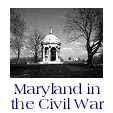

When Stonewall Jackson moved into Maryland in September of 1862, Colonel Bradley Johnson and much of his staff from the 1st Maryland Infantry, which had just disbanded, offered their services to Jackson. These men filled a variety of positions until new positions in the army could be found for them.
Most of the common soldiers in the 1st Md. returned to Richmond to enjoy it's pleasures, and rest their weary bones. But many soon became bored and home sick. But they couldn't go home. Having crossed the Potomac, to fight for the Confederacy, the Maryland boys had virtually signed up for the duration of the war, for at home the only thing that awaited them was a cell. Some of the men joined the artillery. A few enlisted in Virginia units. Most joined the cavalry-they were tired of marching every where. But a handful were determined to create a new 1st Maryland Infantry. They succeeded beyond their wildest hopes. The new 1st Maryland, which was later re-designated the 2nd Maryland Infantry in order to distinguish it from the original regiment, would have a history as glorious, if not more so then its' ancestor.
A core of officers from the 1st Maryland, mainly Captains William Murray and James Herbert, and Lieutenants George Thomas, Clapham Murray and William Zollinger began recruiting veterans and men fresh from Maryland. Quickly two companies under Cpt. Murray and Cpt. J. Parran Crane were organized. They were quickly followed by three more. By October 13, 1862 over five hundred men had joined the growing battalion, which was quickly assigned to General George Hume "Maryland" Steuart's command in Winchester.
Steuart ordered the battalion to hold an election to which Cpt Herbert was elected Major. In November, Steuart was ordered elsewhere, and the Md. Bn was temporarily assigned to the command of General William "Grumble" Jones, who had taken command of Munford's Brigade of cavalry. The battalion joined Jones near Strasburg. During this period a sixth company was completed. Also during this period, Captain W. W. Goldsborough, who had been Col. Johnson's adjudant, recovered from the wounds he had aquired at Second Manassas, and recruited his own company, which joined the Maryland Battalion at New Market on Jaunary 2, 1863.
Jones took out of New Market the day Goldsborough arrived on a short expedition to Moorefield, so the reunion of the Marylanders had to wait for about another week. When the battalion returned to New Market, with the addition of Goldsborough's company, it was now a regiment, so Jones ordered new elections. Colonel Johnson, now on Court Martial duty in Richmond was elected Lieutenant Colonel, but he declined the offered, deferring command of the regiment to the men who had organized it. Major Herbert was elected LTC, and Cpt. Goldsborough was elected Major and appointed his adjudant.
According to Goldsborough, the regiment, now known as the 2nd Maryland Infantry to distinguish it from it's predecessor, spent the winter in the Valley, moving through blinding snow storms betweeen Lacey's springs, Edenburg, Newmarket, Woodstock and Harrisonburg. They had no occassion to engage the Federals, but participated in moving stores of pig iron, essential to the war effort. It was a cold, harsh winter, and most of men had no tents. They slept in their blankets and in the morning "it was no unusal thing to see several hundred men arise from a covering of a foot of snow that had fallen during the night."
On the night of March 25, 1863, Captain Bond, Co. A., 1st Md Cavalry, took it upon himself to attack Federal pickets at Kernstown. His action woke a hornets nest and Bond found himself, enroute to Jones' camp on the morning of the 25th, being hotly persued by Federal cavalry. A courier was dispatched to warn Jones. Passing through the camp of the 2nd Md. on his way to Jones' HQ, the courier gave the alarm. Jones writes "Herbert and his noble men, without waiting for orders, seized their arms and flew to the protection of our trains in quest of forage about Woodstock. Their conduct on this occassion is worthy of the highest praise."
On April 21st Jones broke camp to begin an expedition with General Imbodden against the B & O Railroad at various points in West Virginia. The 2nd Md. marche dwith Jones' cavalry and artillery as far as Moorefield, where Jones and Imbodden decided to move on with only cavalry. The 2nd Md. returned to camp near Harrisonburg.
Sometime in mid-May the regiment, along with the Baltimore Light Artillery and Co. A. of the 1st Md. Cavalry were detached to a postion on Fisher's Hill. Once again the Marylanders in the various branches of the Army were working again; and shortly afterwards the old confederate dream of a Maryland Line was re-awakened. Colonel Johnson was ordered by the Secretary of War to organize the various Maryland units under one command, his. He received his orders in Richmond on June 22nd, and immediately set out with two officers who had recently recuperated from wounds to join the Marylanders in the Valley. Unknown to Johnson, the Army of Northern Virginia was also in motion, moving north. Johnson would not catch up with his fellow Marylanders for several weeks.
Shortly after their arrival at Fisher's Hill, General Albert Jenkins arrived and placed the detachment under his command. On June 12th jenkins was ordered to join General Ewell near Front Royal. The Maryland Line was directed to join up with General Early near Newtown. On the 13th the Marylanders encountered Federal cavalry and artillery just beyond Newtown. they formed in line of battle and the Baltimore Light dueled the Union artillery until Early arrived. Early directed Herbert to drive the Federal skirmishers forward which he did. The following day the 2nd Md. participated in the enclosure of Winchester, they were directed to amuse the enemy, keeping his attention while the rebel assault developed. During this manuver the regiment repulsed two enemy assaults. On the morning of the 15th the regiment particpated in the final assault, capturing Star Fort. Also at this time the regiment was again attached to Steuart's Brigade, now part of Edward Johnson's Diviison, Ewell's 2nd Corps.
Once across the Potomac, Steuart's Brigade was sent on a meandering foraging expedition to Chambersburg by way of Mercersburg and McConnelsburg. The object was to collect cattle, horses, shoes, etc. During this expedtion the brigade was supported by Major Harry Gilmor's partisan rangers. The Brigade went into camp at Carlisle on June 28th. The men expected to be in Harrisburg the following day or so. But next morning they counter marched over the road they had taken to Carlisle. Lee was concentrating his forces. At this point Steuart was only 30 miles from Gettysburg. His men, as with most of Johnson's division, would march nearly 50 miles to get there.
Johnson's division arrived in force late in the afternoon, and was compelled to move from west to east around the town to take it's position in line on the far Confederate left at the base of Culp's Hill. The following day Ewell was to attack the Federal right in conjunction with Longstreet's attack on the Federal right/center. But Longstreet did not attack into late in the day, and Ewell advanced around 5 o'clcok in the evening. Culp's Hill was a rock strewn wooded hill. Near it's ridge was a line of hastily erected breastworks. These positions were not abandonded as some historians claim. Earlier in the day a portion of 12th Corps had been pulled out and moved to the center to repulse Longstreet, but General Green had refused his line, filling the breastworks with a thin line of defenders. Attacking up hill, with daylight fading, the 2nd Md., 37th, 23rd and 10th Virginia, and 3rd North Carolina reached the breastworks and began a bloody duel with 12th Corps. The 1st Norht Carolina, held in reserve, came under fire. Returning fire, the 1st N.C. fired into the rear of the 3rd N.C. and 2nd Md., killing several men. These two regiments met Green's Brigade at a bloody angle. Colonel Herbert fell, wounded three times. The Marylanders and Tar Heels managed to breach the works and drive Green's men out, and there they remained until the following morning when a heavy artillery barage and several Federal assaults forced them back down the hill. During these assaults the 2nd Maryland came under attack by several Federal Maryland units.
Returning to Virginia, Steuart's Brigade proceeded to Martinsburg, where they destroyed tracks of the B & O. They then moved to Winchester and then to Orange Court House. Here the brigade went into camp and under Steuart's direction, began daily drills. Colonel Johnson joined the regiment at this time. On August 23rd General Johnson held a review of his division and according to Goldsborough, the 2nd Maryland took the division honors, and was allowed to march at the head of the column during the Army of Northern Virginia's Grand Review, which was held several days later. Standing next to General Lee during the review, General Johnson reputely said to Lee as the Marylanders marched smartly by "General, they were as steady as that at Gettysburg." Lee honored the regiment by taking off his hat as they passed.
By now the regiment's strenght had been reduced to that of a battalion but was soon augumented by the arrival of Company H. This company had supposedly enlisted for the cavalry, but for some reason had been assigned to the 2nd Maryland. They were considered a bad lot, and most of the men had never even set foot in Maryland. The company commander and several of his officers were soon relieved, and most of the bad apples were quickly weeded out though.
After the grand review the regiment relaxed at Orange Court House into September, then moved to Merton's Ford on the Rapidan, remaining there until October 8th. When it took part in a short manuver by Ewell to Bristow Station, where it was engaged in several sharp skirmishes and assisted in tearing up part of the Manassas Gap Railroad. The regiment then fell back to Brandy Station, where it remained until October 22nd. On the 22nd the regiment was detached from Steuart's Brigade and assigned to the Maryland Line. Once again the effort was afoot.
The regiment moved by rail to Hanover Junction. Here they were joined by the 1st Maryland Cavalry, the Baltimore Light Artillery, the 1st Md Artillery (Dement's) and 4th Md. Artillery (Chew's). An order went out throughout the Army of Northern Virginia for all Marylanders in the ranks who wished to join the Maryland Line to make that wish known to their commanders. Few men joined, for after three years of war they had formed strong bonds with the men with whom they fought under Virginia and North Carolinia's flags (out side of Maryland, these two states had the largest percentage of Maryland troops, some regiments had entire companies of Marylanders).
The Line wintered at Hanover Junction. By May, the 2nd Maryland's strength was 325 men. Shortly after May 1st Dement and Chew's batteries were sent to the front and joined Lee at the Wilderness and the battles that followed, never to fight beside their fellow Marylanders again. On May 8th the 2nd Maryland broke camp and moved to defend the bridges over the North and South Anna Rivers. A few days later General Breckinridge's command took up a position along thevirginia Central Railroad, and the 2nd Maryland was assigned to his command, but oddly remained an independent command, attached to no brigade.
The army fell back to Cold Harbor. On the night of June 2, 1864 the men of the 2nd Maryland, after a long march, fell exhausted onto the ground to sleep. Their poisition was behind a salient held by Edgar's Battalion in General Echols Brigade. Before dawn on the morning of the 3rd the Federals began a lively exchange of fire. Through it many of the Maryland boys, still dead tired continued to sleep, so hardened were they now to the noise of battle. Within moments the salient was over run and Federal troops began firing at the sleeping men. From their blanket the Marylanders rose into a hornet's nest and mounted a brave counter-attack. They reached the salient in the nick of time as the Federals were turning two guns loaded with double shot, to fire into the Confederate ranks. The Marylanders gained the guns and several trained in their use manned them, firing canister after canister until "nearly a hundred men were stretched on the plain, from the fire of the Second Maryland Infantry, and many others captured." (Richmond Sentinel June 6, 1864)
Breckenridge left Cold Harbor on June 6th to join Early in the Valley. The 2nd Md., to their dismay was left behind, attached to Frye's Brigade, Heth's Division, Hill's Corps; and moved to the right rear of the line as reserve. On June 13th the 2nd Md was used as skirmnishers near White Oak Swamp and participated in a hot engagement with Federal skirmishers. On the 18th it crossed the James at Drewry's Bluff, and took a train to within a miloe of Petersburg. Here they established breastworks. The siege of Richmond/Petersburg had begun.
For the next two months the regiment lived in the trenches, coming forth from time to time to exchange shots with the Federals, but little else. In August Grant began to move around Lee's right toward the Weldon Railroad. Hill attacked 5th Corps near the railroad on August 18th. While a portion of 5th Corps battled Hill, another dug in near the rail line. On the 19th Hill attempted to dislodge them from their works. In the first days fight the 2nd Maryland was hotly engaged. On the second day, as a part of General Archer's Brigade, it managed to breech the Federal works, but could not hold it's position alone and was soon driven back. For nearly an hour the Marylanders battled inside the Federal works, much of it hand to hand. When they fell back, nearly a third of their number lay dead, wounded, or were prisoners.
After Weldon, the 2nd Maryland returned to Battery 37, manning trenches. On September 2nd they moved to a position between the Weldon and southside Railroads. Here they helped to construct a hexagonal fort on Peebles Farm. On the 30th Archer's men were moved to nearby Star Fort. That same day a Federal attack carried the hexagonal fort the Marylanders had labored so hard to build. Heth's Division counter-attacked. A bloody seven hour fight ensued, ending with Heth pulling back, counter-marching and taking a new positon on General Warren's right, which he attacked the following morning, October 1st. After another bloody day of fighting Heth pulled back. In the two days at Peeble's Farm the 2nd Maryland had lost fifty-three dead and wounded.
The Marylanders were not much in the fray after this. The winter passed. On February 5, 1865 they fought at Hatcher's Run. Then, slowly at first, the defense of Petersburg and Richmond, began to unwravel. On the night of April 1st, a portion of theever dwindling battalion was cut off from the main body and captured. Thirty two men in all. Then the order came to move west out of the works. The Federals were close behind. In the press of men moving west, the attacks on the column, the Marylanders became seperated from one another. They continued west in two seperate squads, re-uniting on the 3rd. Twenty-three men and not a single commissioned officer. They continued west. Captain Torsch soon caught up with them to assume command. By the time the once proud regiment reached the sleepy hamlet of Appomattox Court House on April 9th, the ranks had swelled to about forty men, present for duty, presnt to surrender.
History provided by Gary Baker of the Association of Carroll's Sacred Trust

| 
| 
| 
| 
|